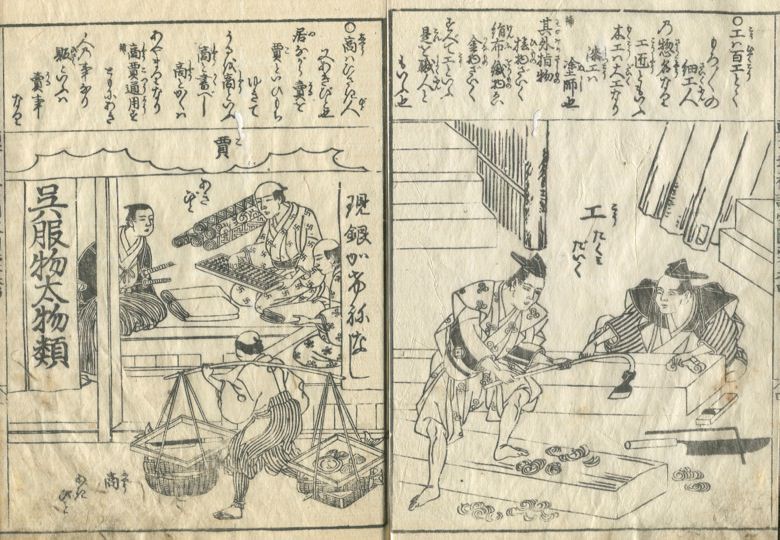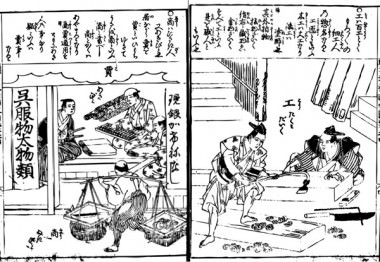The carpenter is drawn on the right.
“工 (Kou)” is written to be an everything thing worker to the text, and is said to it also as an “artisan” as a general term.
“woodwork” is called “carpenter” ,”painting” is called “lacquerer”, although divided, it is said that other “指物 (it smells [ which it puts and puts into accessories and crevices, such as thing: “ornamental hairpin”, ])” and “Himono-zaiku (a string’s work: workmanship which bends boards, such as a hinoki and a Japan cedar, and builds a vessel)”, “textiles”, “hardware work”, etc. are collectively called “工 (Kou)”, and it is also called a “craftsman”
There is a figure of the carpenter who covers a “plane” which a shrine carpenter uses in a picture.
The merchant is drawn on the left.
It is said that there are the people and the seller who buy it in trade, and the thing of those who buy it is called “quotient.”
“Shou” which writes the “mouth” of a quotient to be “old” is written to be those who sold and buy.
Moreover, it is said that “販 (Hisasi)” is selling.
The shop dealing in fabrics for komono is drawn on the picture, and those who sell marine products and walk are in the salesclerk and visitor who are flipping the abacus in inside, and outside.
右には大工が描かれています。本文には、「工(こう)」はもろもろもの細工人と書かれており、総称としては「工匠(こうしょう)」とも言われます。「木工」を「大工」と言い、「漆工」を「塗り師」と分けていますが、その他の「指物(さしもの:かんざしなどの装飾品や隙間に入れるかぐなど)」や「檜物細工(ひものざいく:檜や杉などの板を曲げて器をつくる細工)」や「織物」「金物細工」などをまとめて「工(こう)」といい、「職人」とも言うそうです。絵には宮大工が使うような「鉋」をかける大工の姿があります。
左には商人が描かれています。商いにおいては買う人と売る人がいて、買う人のことを「商」と言うそうです。商の「口」を「古」と書く「しょう」は売り買いを行う人と書かれています。また、「販(ひさし)」とは売ることだそうです。絵には呉服店が描かれており、中でソロバンをはじいている店員と客、外には海産物を売り歩く人がいます。

